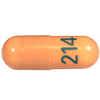Gabapentin
This is a prescription item
We’ll collect your veterinarian’s information at checkout to authorize the prescription.

Don’t have a veterinarian? Book an appointment with Vetster
 Additional Information About Your Prescription
Additional Information About Your Prescription
 Out of stock
Out of stock
 Thank you, we will notify you when this product is available.
Thank you, we will notify you when this product is available.
What is Gabapentin?
Gabapentin is a medication for the treatment of seizures. It is also used to help with chronic pain. Although Gabapentin is not FDA-approved for use in veterinary medicine, it is a commonly accepted practice for veterinarians to prescribe this medication for dogs. Gabapentin requires a prescription from your veterinarian, and is sold per capsule.
For:
Dogs
Benefits:
- Treats seizures
- Helps manage chronic pain often associated with cancer or arthritis
How does Gabapentin work?
Gabapentin stabilizes electrical activity in the brain which prevents seizures caused by excessive electrical activity. Gabapentin mimics the activity of GABA (a neurotransmitter) which helps to calm the nerve activity in the brain.
Cautions:
Unless the benefits outweigh the risk, do not use Gabapentin in pregnant or nursing pets.
Brand Name:
Neurontin
Generic Name:
Gabapentin
What is the most important information I should know about Gabapentin?
Gabapentin is a prescription medication not FDA approved for veterinary use; however, it is a commonly accepted practice for veterinarians to use this medication in dogs. Gabapentin is available as 100 mg, 300 mg, and 400 mg capsules. The usual dose to treat seizures in dogs is 4.5 to 13.5 mg per lb every 8 to 12 hours. As an aid in chronic pain treatment or cancer pain in dogs, the usual dose is 1.4 mg per lb once a day.
What should I discuss with my veterinarian before giving Gabapentin to my pet?
Tell your veterinarian if your pet has kidney disease. The dose of Gabapentin may need to be adjusted. Unless the benefit outweighs the risks do not use Gabapentin in pregnant or nursing pets.
How should Gabapentin be given?
Give this medication exactly as directed by your veterinarian. If you do not understand the directions ask the pharmacist or veterinarian to explain them to you. Do not give antacids within 2 hours of giving Gabapentin. Antacids can affect Gabapentin blood levels. Drug interactions may occur when giving any narcotics such as hydrocodone or morphine. Do not suddenly stop the use of Gabapentin. Store Gabapentin at room temperature away from moisture and heat. Keep this medication away from children.
What are the potential side effects of Gabapentin?
If any of the following serious side effects occur, stop giving Gabapentin and seek emergency veterinary medical attention: an allergic reaction (difficulty breathing; swelling of the lips; tongue or face; hives). Side effects that can occur in dogs may include drowsiness, loss of balance, swelling of the limbs, and vomiting or diarrhea. Talk to your veterinarian about any side effect that seems unusual or bothersome to your pet.
What happens if I miss giving a dose of Gabapentin?
Give the missed dose as soon as you remember during the same day. However, if you don't remember until the next day, skip the dose you missed and give only the next regularly scheduled dose. Do not give a double dose of the medication.
What happens if I overdose my pet on Gabapentin?
Seek emergency veterinary medical treatment. Symptoms of Gabapentin overdose include reduced activity, excessive sleepiness, loss of balance, and depression.
What should I avoid while giving Gabapentin to my pet?
Gabapentin should not be used in pets allergic to it. Do not use in pregnant or nursing pets. Use with caution in pets with kidney disease. Do not give antacids within 2 hours of giving Gabapentin. Consult your veterinarian before giving any narcotic such as hydrocodone or morphine since drug interactions can occur.
What other drugs will affect Gabapentin?
Tell your veterinarian if your pet is being given antacids or narcotics for pain. Drugs other than those listed may also interact with Gabapentin. Talk to your veterinarian or pharmacist before giving any prescription or over the counter medicines including vitamins, and supplements.
Gabapentin Directions:
- Please refer to the chart below for proper dosage.
Do not give antacids within 2 hours of giving this medication.
Gabapentin Dosage:
| Weight | Dosage |
|---|---|
| all weights |
For pain: 1.4 mg per pound once a day. |
| Cats | Do not use! |
|---|
| Horses | Do not use! |
|---|
Storage:
Should be stored at room temperature, away from moisture and light.
Gabapentin Ingredients:
| Active Ingredient (per capsule) | Amount |
|---|---|
| Gabapentin | 100 mg |
| Active Ingredient (per capsule) | Amount |
|---|---|
| Gabapentin | 300 mg |
| Active Ingredient (per capsule) | Amount |
|---|---|
| Gabapentin | 400 mg |
 Swipe
Swipe
Customers who bought also boughtView All
 Swipe
Swipe





































